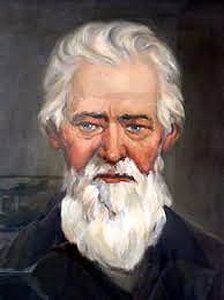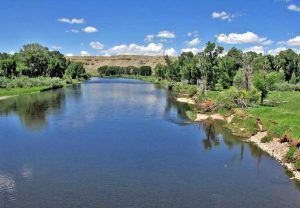Fort Platte, Wyoming, was built by Lancaster Lupton, an ex-army officer turned fur trader, in 1840. It was located about one mile below Fort Laramie (called Fort William at the time) on the right bank of the North Platte River. At that time, Fort William was being managed ineffectively by competing fur traders who had an inadequate supply system, and their attempts at gardening had been unsuccessful. Lupton, who had previously established Fort Lupton in Colorado, already had a sufficient supply system and established Fort Platte to exploit the competitor’s weaknesses.
Trade goods for the rival posts came out in wagons over the Platte Valley road from St. Joseph, Missouri, or over the trail from Fort Pierre, South Dakota, on the upper Missouri River. On the return trip, packs of buffalo robes and furs were sent down to St. Louis, Missouri. Competition in the declining fur trade led to open sales of alcohol to the Indians, and their drunken debauchery was noted by several travelers in the early 1840s.

Lancaster P. Lupton
Though the post was a commercial success, Lupton went bankrupt in 1842, and the fort was sold to the veteran firm of Pratte & Cabanne in 1843, owned by Bernard Pratte and Jean Pierre Cabanne. Pratte and Cabbanne operated Fort Platte from 1843 to 1845. Its operations were moved to Fort Bernard in 1845 to capture the travelers west on the Oregon Trail, and the original fort was abandoned.
Rufus B. Sage described the fort in his 1846 book Rocky Mountain Life:
“Fort Platte, being next to Fort Hall (Idaho), the most important point on the route to Oregon, calls for a brief description. This post occupies the left bank of the North Fork of Platte River, three-fourths of a mile above the mouth of the Laramie River upon the direct wagon road to Oregon via South Pass.
It is situated in the immediate vicinity of the Oglala and Brule divisions of the Sioux Nation but is a little remote from the Cheyenne and Arapaho tribes. Its structure is a fair specimen of most of the establishments employed in the Indian trade. Its walls are “adobes,” four feet thick by 20 feet high — enclosing an area of 250 feet in length by 200 broad. At the northwest and southwest corners are bastions that command its approaches in all directions.
Within the walls are some 12 buildings in all, consisting as follows: Office, store, warehouse, meat house, smith’s shop, carpenter’s shop, kitchen, and five dwellings, — so arranged as to form a yard and corral, sufficiently large for the accommodation and security of more than 200 head of animals. the number of men usually employed about the establishment is some 30, whose chief duty it is to promote the interests of the trade and otherwise act as circumstances require.
The Fort is located in a level plain, fertile and interesting, bounded upon all sides by hills, many of which present to view the nodding forms of pines and cedars that bescatter their surface, — while the river bottoms, at various points, are thickly studded with proud growths of cottonwood, ash, willow, and box-elder, thus affording its needful supplies of timber and fuel.”
There are no remains of the fort today, with the exception of a historic marker located about a mile west of Fort Laramie.
©Kathy Alexander/Legends of America, updated February 2024.
Also See:

